Dell XPS 15 L521X: A Detailed First Look
by Jarred Walton on July 25, 2012 1:10 AM ESTDell XPS 15 General Performance
We start as usual with our general performance application benchmarks. We’re reaching the point where we now have quite a few notebooks in our updated Mobile Benchmark suite, and we’ve tried to select some reasonable comparison points. Given the preliminary nature of our benchmark results (i.e. potential for CPU and/or GPU throttling), we have not yet added the XPS 15 to Mobile Bench, but we will do so when we have a final release BIOS that addresses our throttling concerns. Here’s the list of laptops we’ll be using for our charts, along with a brief overview of their specs. The full specs for each laptop can be found in their respective reviews, which we’ve linked in the table below.
| Laptop Configuration Overview | ||||
| Laptop | CPU | Graphics | Storage | Battery |
| Acer Aspire V3-571G | Intel i7-3610QM | GT640M/HD4000 | HDD | 48Wh |
| Acer Aspire S5 | Intel i7-3517U | HD4000 | SSD | 35Wh |
| Acer TimelineU M3 | Intel i7-2637M | GT640M/HD3000 | SSD | 55Wh |
| AMD Trinity Prototype | AMD A10-4600M | HD7660G | SSD | 56Wh |
| ASUS N56VM (Prerelease) | Intel i7-3720QM | GT630M/HD4000 | HDD/SSD | 56Wh |
| ASUS G74SX-A2 | Intel i7-2630QM | GTX560M/HD3000 | SSD | 90Wh |
| Clevo W110ER | Intel i7-3720QM | GT650M/HD4000 | Hybrid (Seagate) | 62Wh |
| Dell XPS 15 (L521x) | Intel i7-3612QM | GT640M/HD4000 | Hybrid (SRT) | 65Wh |
| Razer Blade | Intel i7-2640M | GT555M/HD3000 | SSD | 60Wh |
| Sony VAIO SE | Intel i7-2640M | HD6630M/HD3000 | HDD | 49Wh |
| Toshiba P755D | AMD A8-3520M | HD6620G | HDD | 47Wh |
We have quite a few SSD-equipped laptops in our list, which will mostly influence PCMark results. The Dell XPS 15 we’re reviewing marks the first time—and certainly won’t be the last!—we’ve had a laptop arrive with support for Intel’s Smart Response Technology. Previously SRT was only available with the desktop Z68 chipset, but with the new Ivy Bridge Panther Point chipsets (see the chipset table at the bottom of our IVB Ultrabook review) laptops with 7-series chipsets (excluding the HM76) all support SRT. Dell uses a Samsung P830 32GB mSATA SSD for SRT caching, and we enabled the higher performing “Maximized” mode with write-back caching as opposed to the lower performing “Enhanced” mode with write-through caching. There is an increased risk of data loss in the event of hardware removal or failure, but HDD removal is highly unlikely to occur on the XPS 15 and in the case of hardware failure there’s already a high chance of data loss. (We always recommend users back up, and back up often!) Note that a system crash doesn’t cause data loss—the Intel BIOS hooks detect an improper shutdown with “unsaved” data in the SSD cache, and that data is then committed to the hard drive on the next boot—it’s actually quite slick.
The other hybrid storage solution that we’ve seen more often is Seagate’s Momentus XT, which has an 8GB cache that AFAIK only functions in write-through caching mode. Going forward, we’ll also see some laptops using alternative caching schemes like Diskeeper/Condusiv Technologies’ ExpressCache software. I do have a laptop undergoing testing right now with an 8GB ExpressCache implementation, and it appears to be less performant than a 32GB SRT cache, but given the discrepancy in SSD size it’s difficult to come to any firm conclusion at this point.
Now let’s get to the benchmark results, starting with PCMark. We ran the XPS 15 in both IGP and dGPU modes, as the presence/lack of Intel’s Quick Sync technology can have a sizeable impact on overall performance according to this metric. We’ve used the best score for each chart on previously testing laptops (e.g. IGP for the Computation results). The XPS 15 results are in green, with the similarly equipped Acer V3-571G results in yellow. We also have results for the ASUS N56VM/N56VZ prototype with both HDD and SSD (light blue) storage, so you can get a feel for the range of performance that the storage solution creates. Note that while the overall design is highly reminiscent of Apple’s current MacBook Pro 15, we do not have current MBP15 Boot Camp results—and anecdotally it appears there is very little cross shopping; people either want an MBP with OS X, or something else with Windows. If/when Anand or Vivek gets around to testing the latest MacBooks with Windows, we’ll add the results to Mobile Bench.

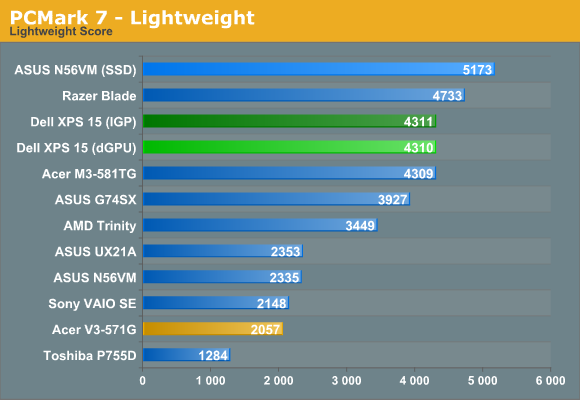

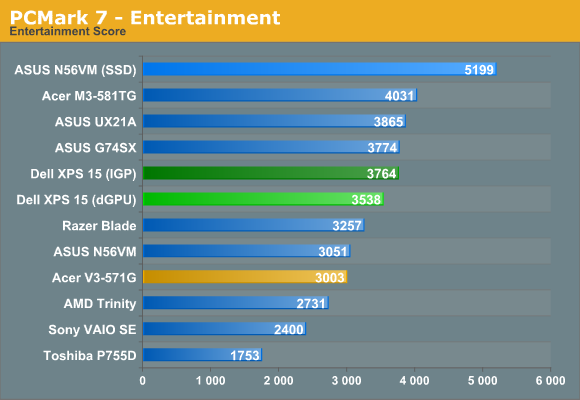

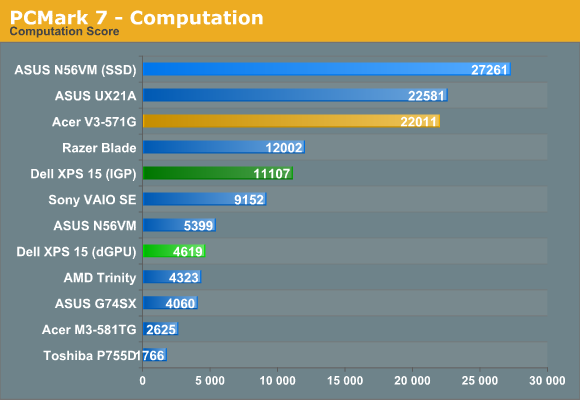
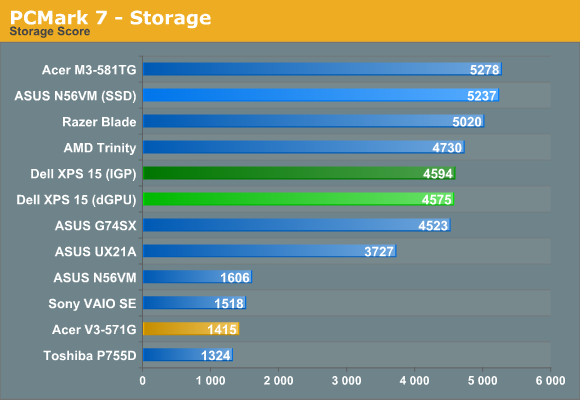
Starting with PCMark 7, our results are actually somewhat surprising. The hybrid Seagate Momentus XT storage in the Clevo W110ER doesn’t improve scores all that much over a typical hard drive (if you can call 25% “not that much”), whereas the 32GB SRT solution in the XPS 15 looks to improve performance by around 75% over an HDD. Of course, if you make the switch to a pure SSD solution (e.g. look at the N56VM scores), PCMark 7’s overall score improves by 135%. That pretty much establishes the expected storage hierarchy: SSD > HDD + SSD Cache > Hybrid HDD > HDD.
There are a few other oddities in the PCMark 7 results worth noting. Both the Creativity and Computation suites benefit tremendously from Intel’s Quick Sync technology. For whatever reason (we tried both the 2696 and 2761 Intel drivers, with similar scores in both cases), the XPS 15 results don’t seem to be in line with other Ivy Bridge laptops. In particular, note how the other three IVB laptops (N56VM, UX21A, and V3-571G) all post Computation scores in excess of 20000, while the XPS 15 has to “make do” with a score of only 11000. This may be yet another instance where throttling is affecting the results, so we’ll wait for updated firmware before trying to draw any final conclusions.
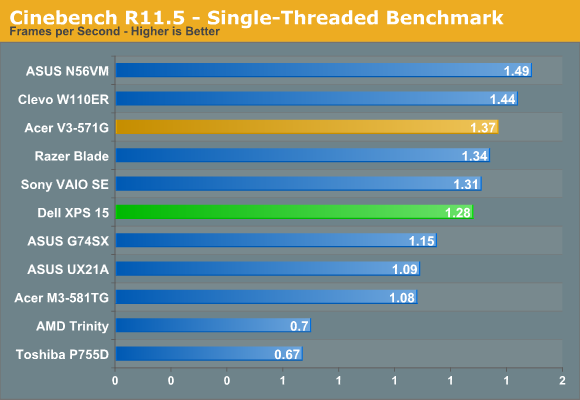
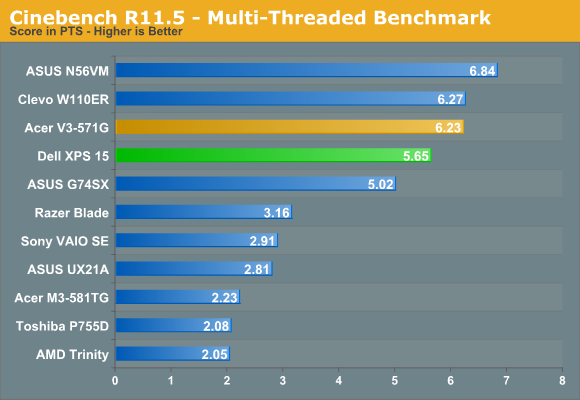
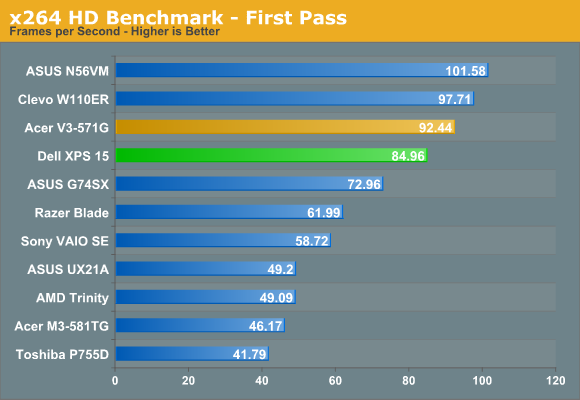
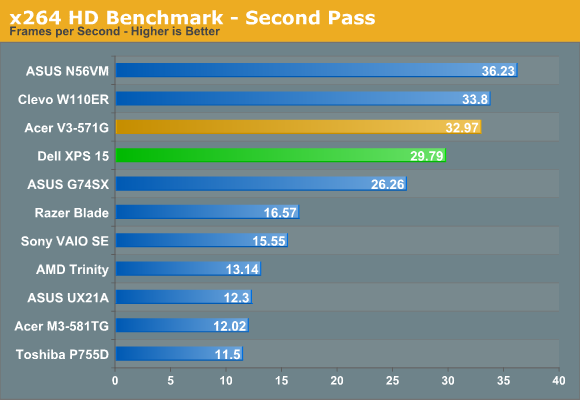
Our CPU-centric tests put the XPS 15 and its 35W i7-3612QM right about where you’d expect. It’s faster than any dual-core processor and outperforms the quad-core Sandy Bridge chips, but it’s a slight step down from the standard voltage 45W IVB quad-cores. Throttling of CPU clocks did not occur during these tests, so it’s only when the CPU and GPU are carrying a significant load the throttling is triggered. As far as we can tell, with the current A04 BIOS, the Dell XPS 15 can pretty much loop a workload like the Cinebench SMP test indefinitely and remain at the maximum Turbo Boost clock (though that may change with updated firmware).
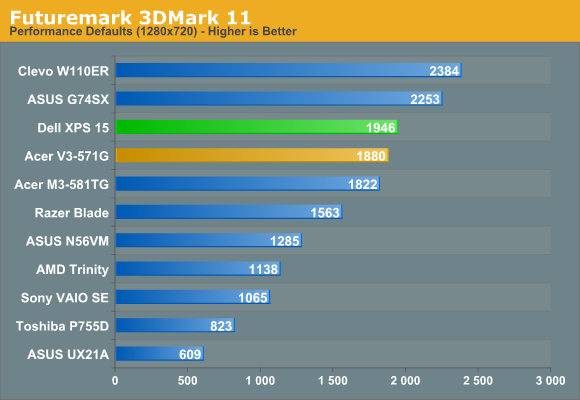
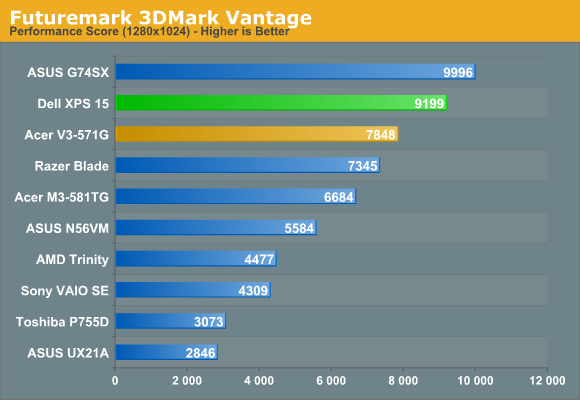
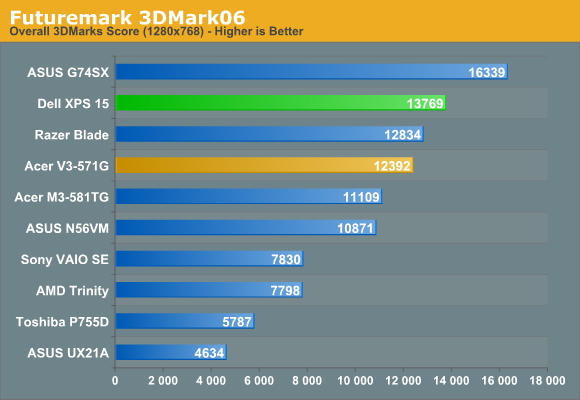
3DMark results also put the XPS 15 and its GDDR5-equipped GT 640M right where you’d expect. It’s a step up in performance over the DDR3-equipped GT 640M in the Acer V3-571G, and it also beats the previous generation GT 555M in the Razer Blade. Meanwhile, the GTX 560M can still win in our synthetic graphics tests, and the GT 650M with GDDR5 also outperforms the XPS 15. There are no real surprises here, but as noted several times already, throttling may be affecting these results—and it’s definitely a factor in the gaming results, which we’ll get to next.










109 Comments
View All Comments
ananduser - Wednesday, July 25, 2012 - link
Well your stress tests are against Anand's own review and many other reviews that have noticed how under long stress tests the MBP gets extremely hot. You're a lucky one.dtolios - Thursday, July 26, 2012 - link
Apple did nothing "new" with the rMBP...the contrary, it got thinner and the thermal envelope of the notebook got "tighter"...It's just that it is using "cooler" components that intel and nvidia put together.
The metal chassis can only insulate so much, and that is true for all manufacturers. Apple cannot beat physics (doh).
Thus really high end GPUs were always out of the question for MBPs, (and all thin/light laptops) despite the amount of money you were willing to throw in for customizing.
CeriseCogburn - Sunday, July 29, 2012 - link
Ha that is so funny to me - I can see that picky elite machead going for the totally silent room, doing the yoga meditation, some breathing exercises, then firing up the MBP to do some spiritual testing - getting that ear on down low next to it, to see if it can hold it's breath, too.That's why the macgineers had to do what they did do - it's the end user's magical idiot silent wet dream, and there are so many of those people... who cares if they burn their crotch off - that's a good thing.
Yeah, it's really sad. Same type of insanity with gaming gpus as they have the sound cranked to the max and often are wearing noise cancelling expensive headgear for sound. I suppose the fan sound would ruin their delicate and selective critical listening enjoyment.
name99 - Saturday, July 28, 2012 - link
The two are really not comparable. Read what Anand said:http://www.anandtech.com/show/6023/the-nextgen-mac...
The takeaways are:
- for many purposes attempting to stress the machine did NOT result in reduced performance
- even when it did, the falloff was not that extreme (5% or so)
- there was no mention of the system ever crashing due to thermal overload (and I've never heard of this in earlier Macbooks, eg my 2nd gen MBA very obviously throttles in hot weather, but it never crashes).
One thing I wonder (Anand hinted at the same thing) is whether this is a consequence of using a 45W part rather than 35W --- Apple has more headroom and is using that AS headroom, not as compute capacity. If so, this would be analogous to the way they under-clock pretty much every iOS device relative to the CPU's rated specs. The exact reasoning is slightly different, but the overall point is the same in both cases --- to balance the tangible, measurable goal of maximum performance against the intangible, unmeasurable goal of delight, where delight is increased by things like longer battery life, consistent performance and, of course, no crashes. The editorial aside would, of course, be that you can't build products that delight if you are purely driven by checklists and measured numbers --- you have to be willing to make tradeoffs, like leaving some performance on the table for the sake of battery life, or stability, or temperature.
[I'm not trying to be rah rah Apple here; I'm trying to point out the real differences between these two products, and the real factors that led to these differences.]
GotThumbs - Wednesday, July 25, 2012 - link
Ok Fanboi. Just remember the fact that Apple is now a PC Assembler. When they first came out...they built their own systems. They were not as successful back then. Now they use Intel chips and other PC components available to any other PC Assembler.Now Apple is a PC Assembler and they are very good at designing fashionable/attractive shells, but don't con your self into thinking Apple is a true innovator. The are very much like the Chinese in the 80's (Sony Tv's, Walkman, etc.). Apple is very good at taking an existing idea...and putting its own spin on it. There are features they have that are not mainstream...like fire-wire...but as the reviewer stated....He doesn't use it and most of the users of today are probably in the same boat. How great is an option or feature...in its not used/needed?
You need to put the Cool-Aid down.
Listen, If you like using Apples products and they do what you need....I'm happy for you. Just don't try and make this a pissing game or who's dad can beat up whose.
I'm really getting tired of the regurgitation of which is king.
Now that Apple is a PC assembler...the reviewers point about the OS is the key. Either you prefer windows or Apples OS.....or any other number of Linux alternatives.
All I'd like is for people to grow up and have a little respect for other peoples choices/decisions.
If it your money...spend it how you wish...but don't act like a 5 year old and sing about your ice-cream or whos king of the hill. It just too school yardish.
All the best and enjoy your computer.
solipsism - Wednesday, July 25, 2012 - link
1) So in 1976 when they first started out they were less successful than they are now as the world' largest publicly traded company? No fucking way! /s2) The parts they use today are more specialized then any other time in Apple's history. Using an Intel processor doesn't change anything as the processors they used previously were also available to others. Just look at the Xbox 360 for proof.
3) Also note that Apple builds their ARM SoCs based on reference designs. Same goes for a lot of other components that Apple doesn't directly own but has invested heavily in and therefore has been given exclusive rights for a set period of time. Their display tech for the iPhone, iPad and now MBP come to mind.
kevith - Wednesday, July 25, 2012 - link
I´l just second your opinion of the pissing contest.And this isn´t even a Mac-review...
CeriseCogburn - Sunday, July 29, 2012 - link
Oh come on, we've got to compare. I'm learning here. Let them express.xype - Wednesday, July 25, 2012 - link
…and Apple was the first to figure it out, it seems.At least Dell made the keyboard area black and put the sleep light in the center, that counts for something, amirite?
It’s kind of weird that Apple’s "think different" is becoming a "everyone be like Apple!". I love my MacBook Pro and iPad, but damn, it would feel nice to see an original design on the (big vendor) PC side now and then.
Why do these companies think people will buy a copy of an Apple design/hardware, if they can get the original just as well? Customers like choice, yes, but choice does not mean 5 vendors making the same laptop all over again.
No wonder the PC makers are struggling, they’re all lead by unimaginative MBA retards.
ananduser - Wednesday, July 25, 2012 - link
Yes PC makers are indeed struggling, Apple being one of them. Apple's PC lineup is also not the pinnacle of mobile computing. Get a grip.